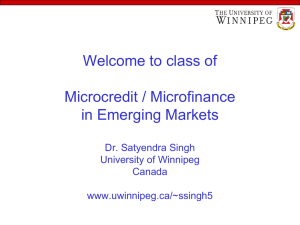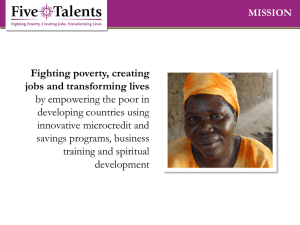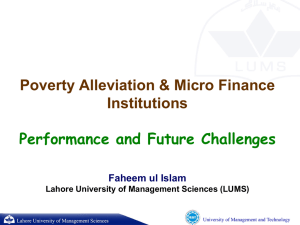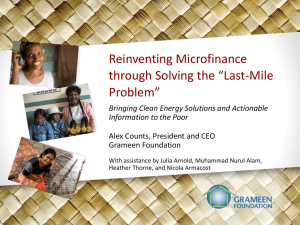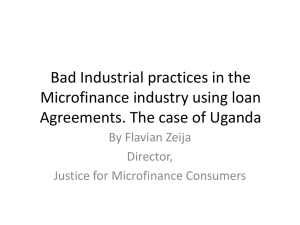Hot Topic – Microloans, Do they Reduce Poverty or Just Help Poor
advertisement
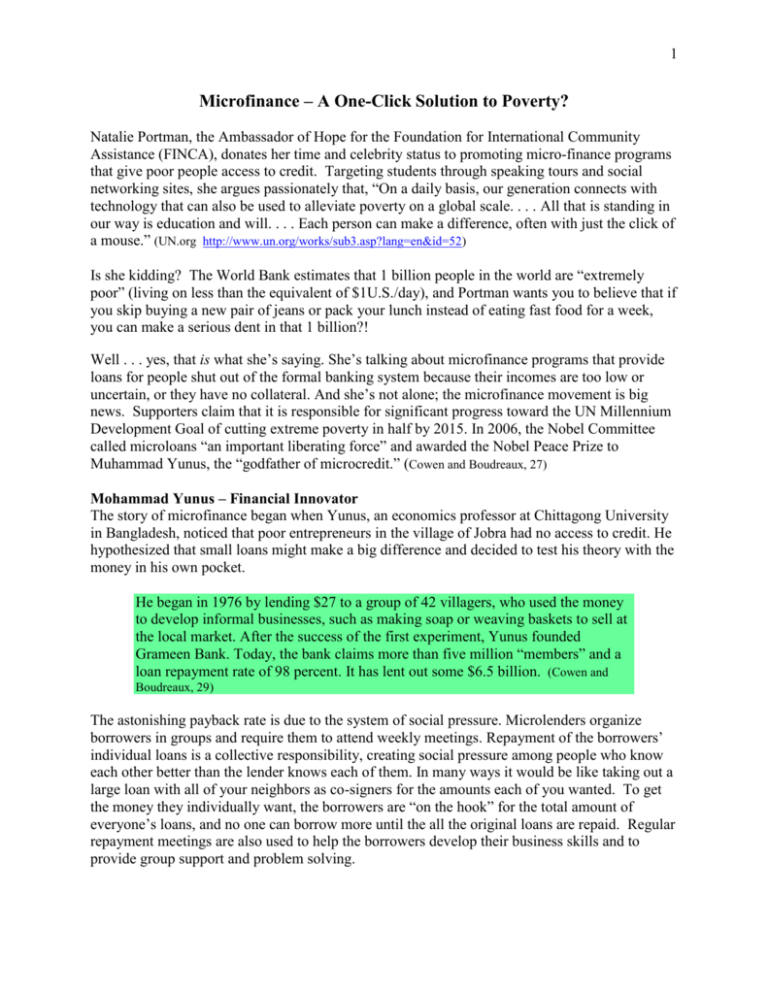
1 Microfinance – A One-Click Solution to Poverty? Natalie Portman, the Ambassador of Hope for the Foundation for International Community Assistance (FINCA), donates her time and celebrity status to promoting micro-finance programs that give poor people access to credit. Targeting students through speaking tours and social networking sites, she argues passionately that, “On a daily basis, our generation connects with technology that can also be used to alleviate poverty on a global scale. . . . All that is standing in our way is education and will. . . . Each person can make a difference, often with just the click of a mouse.” (UN.org http://www.un.org/works/sub3.asp?lang=en&id=52) Is she kidding? The World Bank estimates that 1 billion people in the world are “extremely poor” (living on less than the equivalent of $1U.S./day), and Portman wants you to believe that if you skip buying a new pair of jeans or pack your lunch instead of eating fast food for a week, you can make a serious dent in that 1 billion?! Well . . . yes, that is what she’s saying. She’s talking about microfinance programs that provide loans for people shut out of the formal banking system because their incomes are too low or uncertain, or they have no collateral. And she’s not alone; the microfinance movement is big news. Supporters claim that it is responsible for significant progress toward the UN Millennium Development Goal of cutting extreme poverty in half by 2015. In 2006, the Nobel Committee called microloans “an important liberating force” and awarded the Nobel Peace Prize to Muhammad Yunus, the “godfather of microcredit.” (Cowen and Boudreaux, 27) Mohammad Yunus – Financial Innovator The story of microfinance began when Yunus, an economics professor at Chittagong University in Bangladesh, noticed that poor entrepreneurs in the village of Jobra had no access to credit. He hypothesized that small loans might make a big difference and decided to test his theory with the money in his own pocket. He began in 1976 by lending $27 to a group of 42 villagers, who used the money to develop informal businesses, such as making soap or weaving baskets to sell at the local market. After the success of the first experiment, Yunus founded Grameen Bank. Today, the bank claims more than five million “members” and a loan repayment rate of 98 percent. It has lent out some $6.5 billion. (Cowen and Boudreaux, 29) The astonishing payback rate is due to the system of social pressure. Microlenders organize borrowers in groups and require them to attend weekly meetings. Repayment of the borrowers’ individual loans is a collective responsibility, creating social pressure among people who know each other better than the lender knows each of them. In many ways it would be like taking out a large loan with all of your neighbors as co-signers for the amounts each of you wanted. To get the money they individually want, the borrowers are “on the hook” for the total amount of everyone’s loans, and no one can borrow more until the all the original loans are repaid. Regular repayment meetings are also used to help the borrowers develop their business skills and to provide group support and problem solving. 2 Since its beginning in the 70s, the microfinance movement has grown exponentially, in part because, as Natalie Portman points out, it’s so easy for people like you and me to participate. With one click, you, too, can help fund collateral-free loans; check out www.kiva.org or www.mercycorps.org, for example. Borrowers post profiles and loan requests online through the lending agencies in their countries. Concerned people around the world choose a project and send in all or part of the requested amount. Some organizations even let lenders post their pictures and send messages to the borrowers. The microfinance organizations manage the funds, monitor the borrowers’ progress, and collect interest and repayment. When the borrowers reach their goals, the online lenders are repaid. The lenders don’t earn interest and their contributions aren’t donations so they’re not tax-deductible, but the huge numbers of lenders tells us that the benefit of knowing that their money helped someone struggling in poverty outweighs the cost. On the Other Hand . . . Natalie Portman and other microfinance cheerleaders have a big following; billions of dollars flow into microfinance every year. But if you’re wondering if it’s really just that simple – ending poverty by sending $25 online – you’re not alone, either. The New Yorker columnist, James Suroweicki, is one of a growing number of financial and economics analysts asking whether microloans are really as good as they sound. Making loans and fighting poverty are normally two of the least glamorous pursuits around, but put the two together and you have an economic innovation that has become not just popular but downright chic. The innovation— microfinance—involves making small loans to poor entrepreneurs, usually in developing countries. . . . This vogue has translated into a flood of real dollars: institutional and individual investments in microfinance more than doubled between 2004 and 2006, to $4.4 billion, and the total volume of loans made has risen to $25 billion, according to Deutsche Bank. Unfortunately, it has also translated into a flood of hype. There’s no doubt that microfinance does a tremendous amount of good, yet there are also real limits to what it can accomplish. Microloans make poor borrowers better off. But, on their own, they often don’t do much to make poor countries richer. (Suroweicki) What Suroweicki is suggesting is that asking whether microloans help poor people live better lives and asking whether microloans fix the conditions that create poverty in a country or region are not the same question. Good point. And, we can use the economic way of thinking to see whether and how well microfinance addresses each. Does Microfinance Reduce Regional Poverty? Proponents claim that by supporting individual entrepreneurs microfinance creates ripple effects that spread through the local economy and eventually beyond. For example, a 2005 study based on surveys in Bangladesh in the 1990s claimed that “. . . access to microfinance programs contributed to the reduction of both moderate and extreme poverty of individuals (particularly women) as well as for the village as a whole . . . and raised per capita household consumption for both participants and nonparticipants.” (Westover, 5) More recently, however, researchers conducting larger, longer-term studies are questioning the accuracy and sustainability of results reported by microfinance institutions (MFIs). 3 The idealized view of microfinance is that budding entrepreneurs use the loans to start and grow businesses – expanding operations, boosting inventory, and so on. The reality is more complicated. Micro loans are often used to “smooth consumption” – tiding a borrower over in times of crises. . . It’s less common to find them used to fund major business expansions or to hire new employees. Most micro businesses aren’t looking to take on more workers. The vast majority have only one paid employee: the owner. As the economist Jonathan Morduch has put it, microfinance “rarely generates new jobs for others.” This matters because businesses that can generate jobs for others are the best hope of any country trying to put a serious dent in its poverty rate. In any successful economies most people aren’t entrepreneurs – they make a living by working for someone else. (Suroweicki) Supporters defend their focus on small business by noting that even if they don’t hire employees, owner-entrepreneurs earn income, and when they spend it, they generate income for others. That makes sense, if it’s true that microloans make small businesses successful, but some economists are questioning even the basic claim that micro-lending promotes entrepreneurship at all. Microcredit does not always lead to the creation of small businesses. Many microlenders refuse to lend money for start-ups; they insist that a business already be in place. This suggests that the business was sustainable to begin with, without a microloan. Sometimes lenders help businesses to grow, but often what they really finance is spending and consumption. (Cowen and Boudreaux, 29) It seems, then, that the answer to our first question – does microfinance reduce regional or national poverty – is “we’re not sure; there’s no clear consensus; and there’s a need for lots more research.” Do Microloans Help the Poor? Did you notice that even the studies pointing out the lack of macroeconomic impacts mentioned increased consumption by poor entrepreneurs? That leads directly to our second question, and there is an emerging consensus here: Evidence is accumulating that microloans help people with inconsistent incomes smooth their patterns of consumption. A study of microcredit in Indonesia found that 30 percent of the borrowed money was spent on some form of consumption. . . . For better or worse, microborrowing often entails a kind of bait and switch. The borrower claims that the money is for a business, but uses it for other purposes. In effect, the cash allows a poor entrepreneur to maintain her business without having to sacrifice the life or education of her child. . . . That is not to say that the poor are out shopping for jewelry and fancy clothes. In Hyderabad, India, as in many other places, we saw that loans are often used to pay for a child’s doctor visit. In the Tanzanian capital of Dar es Salaam, Joel Mwakitalu, who runs the Small Enterprise Foundation, a local microlender, told 4 us that 60 percent of his loans are used to send kids to school . . . (Cowen and Boudreaux, 29) “Bait and switch” sounds bad – but maybe that’s only if our focus is macroeconomic, on the larger regional or national economy. A microeconomic focus - on the lives of the poor people receiving loans – reveals greater justification for the enthusiasm of Natalie Portman and the oneclick lenders. Look again at the reported patterns of spending: [M]icrofinance programs . . . [increase]. . . individual and household income levels, as well as improving healthcare, nutrition, education, and helping to empower women. . . . Furthermore, it has been demonstrated by some research that microfinance programs increase access to healthcare, making preventative healthcare measures more affordable to the poor. In addition, more children are being sent to school and staying enrolled longer. . . . Finally, it has been shown that such programs can help borrowers to develop dignity and self-confidence in conjunction with loan repayment, and self‐sufficiency as a means for sustainable income becomes available. Since microfinance services are primarily focused on women, . . . [they are ] . . . providing opportunities for women to take on leadership roles and responsibilities. (Westover, 4) Other benefits of microcredit include the education and empowerment of small borrowers and the accumulation of savings – although not necessarily in the form that wealthier people might recognize. “Sometimes microcredit leads to more savings rather than more debt. . . . A cash hoard kept at home can be lost, stolen, taken by the taxman, damaged by floods, or even eaten by rats . . . relatives knock on the door and ask for aid. In small communities it is often very hard, even impossible to say no, especially if you have the cash on hand. . . In rural Guerrero State, in Mexico, for example . . . most people who saved cash did not manage to hold on to it for more than a few weeks or even days. . . . Under these kinds of conditions, a cow (or a goat or pig) is a much better medium for saving. It is sturdier than paper money. Friends and relatives can’t ask for small pieces of it. If you own a cow, it yields milk, it can plow the fields, it produces dung that can be used as fuel or fertilizer, and in a pinch it can be slaughtered and turned into saleable meat or simply eaten. With a small loan, people in rural areas can buy that cow and use cash that might otherwise be diverted to less useful purposes to pay back the microcredit institution. So even when microcredit looks like indebtedness, savings are going up rather than down.” (Cowen and Boudreaux, 31) So the answer to our second question – whether microloans helps the poor – is clearly “yes!” Opportunities are improved, incomes are increased and financial planning is easier. Life is better for many poor people. 5 Conclusion It seems, then, that there’s bad news and good news, depending on which question we ask. The economic way of thinking is a useful tool in helping us separate those questions and to evaluate for ourselves the benefits of making a one-click microloan. Microcredit is making people’s lives better around the world. But for the most part, it is not pulling them out of poverty. . . . Bangladesh, where Grameen Bank was born, is still a desperately poor country. The more modest truth is that microcredit may help some people, perhaps earning $2 a day, to earn something like $2.50 a day. That may not sound dramatic, but when you are earning $2 a day it is a big step forward. . . . With microcredit, life becomes more bearable and easier to manage. The improvements may not show up as an explicit return on investment, but the benefits are very real. If a poor family is able to keep a child in school, send someone to a clinic, or build up more secure savings, its well-being improves, if only marginally. This is a big part of the reason why poor people are demanding greater access to microcredit loans. . . . If this portrait sounds a little underwhelming, don’t blame microcredit. The real issue is that we so often underestimate the severity and inertia of global poverty. Natalie Portman may not be right when she says that an end to poverty is “just a mouse click away,” but she’s right to be supportive of a tool that helps soften some of poverty’s worst blows for many millions of desperate people. (Cowen and Boudreaux, 31) Discussion Questions 1. The discipline of economics is traditionally divided into micro- and macro-economics, defined by Professors Walton and Wykoff in Understanding Economics Today as Microeconomics: The study of the individual parts of the economy; the household and the firm . . . Macroeconomics: The study of the sum total of economic activity, dealing with the issues of growth, inflation, and unemployment . . . Based on those definitions, and on the quotes in the reading, which of our two questions about microfinance is a microeconomic question and which is a macroeconomic question? 2. There are many assertions in the reading that micro-lending helps poor people. How can it help the poor and not reduce poverty? Explain how this is possible and list 2 reasons critics doubt that microfinance will have a significant impact on poverty. 3. There seems to be a consensus that microfinance is often diverted from the borrowers’ businesses to consumption by their families. What immediate benefits are generated? 4. What things do borrowers often “consume” that might generate long term benefits, and why do critics not believe these benefits will reduce poverty? 5. A key tool of economic reasoning is opportunity cost analysis. The opportunity cost is what a decision-maker gives up in making a choice. Another way to think of it is as the “nextbest” alternative – the one that will be given up. What’s the opportunity cost to you of a $25 6 click on the internet to fund a micro-finance loan? Be precise in your answer: opportunity cost is not all the things you could do with $25; it’s what you would do. 6. One of the criticisms of microlenders is that they charge such high interest rates that they further impoverish poor businessmen by enticing them into business ventures with returns too low to pay off the loans, trapping them in debt. Vijay Mahajan, the chief executive of Basix, an Indian rural finance institution, . . . concludes that microcredit “seems to do more harm than good to the poorest.” One reason could be the high interest rates charged by microcredit organizations. Acleda, a Cambodian commercial bank specializing in microcredit, charges interest rates of about 2 percent to 4.5 percent each month. Some other microlenders charge more, pushing most annual rates to between 30 percent and 60 percent. . . . [I]f poor clients cannot earn a greater return on their investment than the interest they must pay, they will become poorer as a result of microcredit, not wealthier. (Karnani, 37) Economists Tyler Cowan and Karol Boudreaux remind us that people’s choices are shaped by their alternatives, and that if poor entrepreneurs are choosing microloans, it’s not because they have no other alternative, but because it’s their best alternative. Most microcredit banks charge interest rates of 50 to 100 percent on an annualize basis (loans, typically must be paid off within weeks or months.) That’s not as scandalous as it sounds – local money lenders demand much higher rates. . . Commentators often seem to assume that the experience of borrowing and lending is completely new for the poor. But moneylenders have offered money to the world’s poor for millennia, albeit at extortionate rates of interest. A typical moneylender is a single individual, well-known in his neighborhood or village, who borrows money from his wealthier connections and in turn lends those funds to individuals in need, typically people he knows personally. . . . [A] moneylender may charge 200 to 400 percent interest on an annualized basis. He will insist on collateral (a television, for instance), and resort to intimidation and some-times violence if he is not repaid on time. The moneylender operates informally, off the books, and usually outside the law. So compared to the alternative, microcredit is often a very good deal indeed. Microcredit critics often miss this point. . . . [T]he real question has never been credit vs. no credit; rather, it is moneylender vs. modern microcredit. Credit can bring some problems, but microcredit is easing debt burdens more than it is increasing them. (Cowen and Boudreaux, 29-30) What, according to Cowan and Boudreaux, is the next-best alternative to microcredit for an impoverished entrepreneur in a developing country? Why is the opportunity cost of borrowing money at 50% or even 100% interest low to such borrowers? 7 7. What do you think: Suppose the critics are right and research confirms that microfinance isn’t an effective tool for fighting poverty. Should that finding affect your decision to make a click and become a micro-lender? Optional Extension: 8. Read the profile/loan request for Motih Mariana Awah Awah posted on Kiva.org on December 10, 2010, and fill in the opportunity cost grid that follows. $1,025 Loan Request Location: Alabukam, Mankon, NW. Province, Cameroon Loan Use: To purchase a motorbike Repayment Term: 25 months Repayment Schedule: Monthly This loan will be disbursed after it is raised. Repayments on this loan will go to you. $625 Raised So Far (mid-December) $400 Still Needed Mariana has faced many difficulties in her life, ranging from ill-health, to the inability to meet her daily needs, to failure to attain quality education, to sickness in her seedlings. Among other challenges, she also has had difficulties with inadequate capital to start up a business of her own. With this loan, she plans to buy a motorcycle which she will use for transportation. She also thinks her business will succeed because in the area where she resides, there are no motorable roads, but motorcycles can access the area smoothly with little or no stress. She will also use it to bring farm products from the interior to the markets. She will also regularly undertake contracts to transport farm products to homes within her locality. Her activities will help her community because they will be able to transport their farm produce with relative ease from farm to market, and transport supplies from market to farm. She will use a fraction of her profit to carry out maintenance and fuel the motorcycle. She will use the remaining proceeds to upgrade her family standard of living and pay for her children’s education. She prefers a loan from GHAPE because of the training she frequently receives, the follow up, and the low cost in obtaining and paying back a loan. The Grounded and Holistic Approach to People’s Empowerment (GHAPE) is a non-profit NGO based in Bamenda, Cameroon. Based on what you learned in the reading, what is Mariana’s likely alternative to borrowing through GHAPE? Suppose you were trying to buy a motorbike to start a messenger business or get to a better job than the one you currently have. How do your alternatives for financing the investment differ from Mariana’s? Why are yours and Mariana’s alternatives different? Would you lend to Mariana through Kiva? Explain your answer in terms of the opportunity cost to you. 8 Teacher Guide 1. The discipline of economics is traditionally divided into micro- and macro-economics, defined by Professors Walton and Wykoff in Understanding Economics Today as Microeconomics: The study of the individual parts of the economy; the household and the firm . . . Macroeconomics: The study of the sum total of economic activity, dealing with the issues of growth, inflation, and unemployment . . . Based on those definitions, and on the quotes in the reading, which of our two questions about microfinance is a microeconomic question and which is a macroeconomic question? Microeconomic question: Does microfinance help poor people? Macroeconomic question: Does microfinance reduce regional poverty? 2. There are many assertions in the reading that micro-lending helps poor people. How can it help the poor and not reduce poverty? Explain how this is possible and list 2 reasons critics doubt that microfinance will have a significant impact on poverty. Microfinance may improve the lives of individual people both immediately and in the short run without generating long-term, large scale changes in the underlying conditions that create poverty. Examples include: Most borrowers do not hire employees or create new jobs – which are the source of income for most people in the developed world. Most microcredit goes to people who have already started businesses rather than producing new enterprises, so the predicted ripple effects are minimal at best. 3. There seems to be a consensus that microfinance is often diverted from the borrowers’ businesses to consumption by their families. What immediate benefits are generated? Poor people are better able to weather crises and maintain a more consistent standard of living if they have seasonal or inconsistent incomes. Microfinance organizations offer training and experience that help poor entrepreneurs develop business skills. Poor people may be able to increase their savings in non-traditional ways. Note the discussion in the reading of the benefits of buying a cow. 4. What things do borrowers often “consume” that might generate long term benefits, and why do critics not believe these benefits will reduce poverty? Education and health care for children improve human capital and increase productivity which may benefit the children in the long run. However, if the underlying conditions of poverty do not change the children may not be able to use their human capital to full advantage or they will take jobs from others who are less qualified, changing who is poor without reducing overall poverty. 5. A key tool of economic reasoning is opportunity cost analysis. The opportunity cost is what a decision-maker gives up in making a choice. Another way to think of it is as the “nextbest” alternative – the one that will be given up. What’s the opportunity cost to you of a $25 click on the internet to fund a micro-finance loan? Be precise in your answer: opportunity cost is not all the things you could do with $25; it’s what you would do. Students may provide a variety of answers; two suggested in the reading are a new pair of jeans or a week’s worth of fast food lunches. The important points to emphasize are: 9 The opportunity cost is unique to the decision-maker – students decide individually what they would give up. The opportunity cost is not all the things each student could do with $25, but what he would do. 6. . . . Economists Tyler Cowan and Karol Boudreaux remind us that people’s choices are shaped by their alternatives, and that if poor entrepreneurs are choosing microloans, it’s not because they have no other alternative, but because it’s their best alternative. (See full question above.) What, according to Cowan and Boudreaux, is the next-best alternative to microcredit for an impoverished entrepreneur in a developing country? Borrowing from a local moneylender. Help students to realize that people’s alternatives are shaped by their circumstances and going to a bank is not an alternative for the extremely poor. Why is the opportunity cost of borrowing money at 50% or even 100% interest low to such borrowers? Because the alternative of borrowing from the money-lender commits the borrower to even higher interest and, often, dangerous intimidation. 7. What do you think: Suppose the critics are right and research confirms that microfinance isn’t an effective tool for fighting poverty. Should that finding affect your decision to make a click and become a micro-lender? Accept a variety of answers. Help students to articulate that they way they answer the question depends on their values and priorities. If their goal is to help individual poor people right now, or if they believe that the dignity of people helping themselves is important, microfinance offers a low-cost option – although not the only option. An opportunity cost of contributing to microfinance might be donating to a charity. Remember that microfinance contributions are not charitable donations and do not qualify for tax credits – which can also be an important consideration, pro or con, for some. For those who believe that it doesn’t make sense to help poor people in a way that doesn’t address the underlying conditions of poverty, the benefits of microfinance contributions may not outweigh the costs. Optional Extension: 8. Read the profile/loan request for Motih Mariana Awah Awah posted on Kiva.org on December 10, 2010, and fill in the opportunity cost grid that follows. (See complete question above.) Based on what you learned in the reading, what is Mariana’s likely alternative to borrowing through GHAPE? We don’t know for sure, but we can assume that going to the bank is not one of them. Borrowing from the money lender or not borrowing at all are her most likely alternatives. Use this question to emphasize to students that not all people face the same alternatives, and poverty greatly restricts people’s choices. Suppose you were trying to buy a motorbike to start a messenger business or get to a better job than the one you currently have. How do your alternatives for financing the investment differ from Mariana’s? You might need a co-signer but you could probably go to a bank or credit union for a loan. You may also have relatives who will make a low 10 cost loan to you. And, if you have a good job, the motorbike company may finance the purchase and allow you to make payments. Why are yours and Mariana’s alternatives different? Because she is poor and lives in a poor country and you do not. Emphasize that, like you with your messenger business plan, Mariana seems to have admirable entrepreneurial characteristics like creativity and willingness to take a risk and work hard to make things better for herself, but that’s not enough given the conditions of her impoverished country. Would you lend to Mariana through Kiva? Explain your answer in terms of the opportunity cost to you. Accept a variety of answers, but insist that students identify the specific alternative use of the Kiva contribution and their personal perception of the benefits of both that use and the Kiva contribution. Below is an example, using an opportunity cost decision-making grid. I would loan her money because I know that what seems like very little to me can make a big difference to her. Opportunity Cost Grid for Loaning Money to Mariana Through Kiva Alternatives: Make a Micro loan to Mariana Do Not Make a loan to Mariana I am helping someone. I can give my money away to a charity and get a tax write-off I can’t do much with $25 but it Perceived Benefits can really make someone’s life I can help poor people in the better and maybe the neighbors U.S. too. Not helping poor people puts pressure on governments and I am 98% I am going to get my money back. international agencies like the IMF and World Bank to find I am helping women in long term solutions to the countries become a more problem of poverty. valuable part of society. Choice X Opportunity Cost X Benefits Refused I can give my money away to a charity and get a tax write-off I can help poor people in the U.S. Not helping poor people puts pressure on governments and international agencies like the IMF and World Bank to find long term solutions to the problem of poverty. 11 Supplementary resources – video: Interview with David Rodman, Senior Fellow, Center for Global Development, Washington D.C.: “Is Microfinance Adequate for Eliminating or Reducing Poverty?” 2 minutes: http://www.youtube.com/watch?v=gnruLLGSbtM John Stossel interview with Prof. Karol Boudreaux, George Mason University and Andrew Mwenda, Ugandan journalist and speaker: “Alleviating World Poverty” 9 minutes: http://www.youtube.com/watch?v=jTAuEn7HhlI Sources Karol Boudreauz and Tyler Cowen. “The Magic of Microcredit,” The Wilson Quarterly. Winter, 2008, pp. 27 – 31. Anis Chowdhury. “Does Microfinance Work? Making It Magazine. August 8, 2010. http://www.makingitmagazine.net/?p=1711 Aneel Karnani. “Microfinance Misses Its Mark.” Stanford Social Innovation Review, Summer, 2007, pp. 33-40. http://www.ssireview.org/images/articles/2007SU_feature_karnani.pdf Shahid Khandker. “Does Micro-finance Really Benefit the Poor? Evidence from Bangladesh” Asia and Pacific Forum on Poverty. pp. 1-18. http://www.adb.org/poverty/forum/pdf/Khandker.pdf La Conquistadora. “Redefining Success: Micro Loan Projects. Success Circuit. April 29, 2010. http://www.successcircuit.com/articles/redefining-success-micro-loan-projects/ James Suroweicki. “What Microloans Miss,´ The New Yorker, March 17, 2008. (http://www.newyorker.com/talk/financial/2008/03/17/080317ta_talk_surowecki#editorsnote UN.org. “End Poverty. Natalie Portman Showcases Microcredit,” The UN Works for the People and Planet. http://www.un.org/works/sub3.asp?lang=en&id=52 Gary M. Walton and Frank Wykoff. Understanding Economics Today, pp. 478-9. Jon Westover. “The Record of Microfinance: The Effectiveness / Ineffectiveness of Microfinance Programs as a Means of Alleviating Poverty, Electronic Journal of Sociology, 2008, p. 5) http://www.sociology.org/content/2008/_westover_finance.pdf

